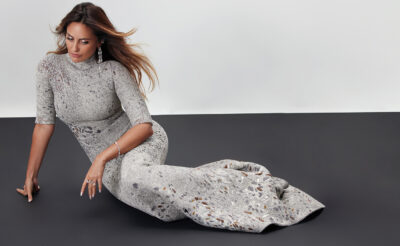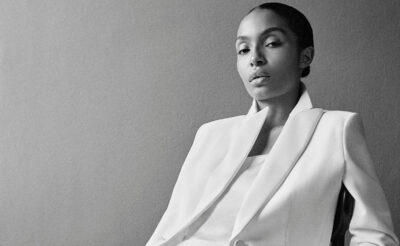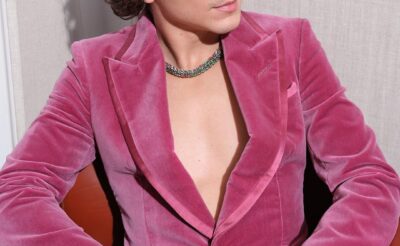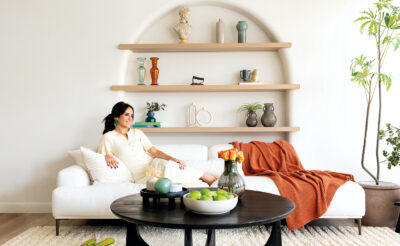After gaining international acclaim in recent years, for our March issue we spoke with Delpozo’s creative director Josep Font about why fashion’s fusion with art is all about house heritage and contemporary couture.
I jumped out of the iconic yellow cab and straight into a pile of densely packed ice-white snow. It whizzed by, and I fixed my sights on the nearest door. An uncontrollable cold wind shot into my face as I dashed. From embellished beanies and boldly coloured gloves to layered pink powdered coats, the unwanted sign of winter was everywhere in New York City in February last year. I meandered with the chattering crowd through skyscraper-high glass doors and out of the chill. Like never-ending beanstalks, trees from an alternative universe climbed high into the space – with misshapen leaves that claimed their place perfectly.
An all white washout engulfed us.
With the flick of a switch the hectic hustling halted. With ease music began to sound, float through the air and consume. Models moved with a slow, measured and reverential gait. Controlled shapes of architectural-style sculptures in a vibrant palette wafted passed me. It was my first real encounter with the art of Delpozo.
“New York is the window to the world, it fits with the concept of Delpozo, as it’s a modern and young city,” says Font. “When I was appointed creative director, we wanted to make a fresh start for the brand, and we felt that New York was the place to do it.” How do you inject a dose of youth into a four-decades-old luxury prêt-à-couture fashion label? It’s been a crucial component as he’s crafted the label’s renaissance in recent years. The word heritage has been on repeat as eager designers take the helm of historic houses – from Hedi Slimane at Saint Laurent and Raf Simons at Christian Dior to Alexander Wang at Balenciaga – it’s a growing buzzword. Founded in 1974 as Del Pozo, the brand sprung to life as a boutique in Madrid. The original owner Jesus del Pozo started off by producing his own designs: firstly for menswear then finding considerably more success with womenswear, and branching out to bridal and fragrances. His critical acclaim founded in Spain was never emulated outside his native country. After his death in 2011, the label was purchased by Perfumes & Diseño SA in 2012 – who hired Font to step in, rebrand and attract the young ones.
After fighting for a position on the New York Fashion Week schedule, Font had international acclaim in his sight. Barcelona-born, he perhaps understands the label’s history better than most, but it wasn’t without its difficulties. “It was very challenging for me,” he says reflecting on the beginning of his tenure. “My goal was to start a new chapter for the brand with a new language, with a fresh and modern vision for the house, while I respected its legacy. Delpozo was a renowned fashion house in Spain with over 40 years of history, and we wanted to preserve it as we incorporated new symbols as well.” This fusion has helped to heighten interest in the brand. It was only a mere five seasons ago that the fashion editors were asking: ‘who are Delpozo?’
It’s the sculptural rigour of his designs that have formed the cornerstone of the label’s newfound vision. Font’s original training as an architect at the Polytechnic University of Catalonia explains this. From graphic shapes and streamlined proportions to rigid silhouettes (with a dose of fairytale frothiness), it’s evident across all aspects of his work, and he agrees: “Almost everything,” says Font. “Thanks to my studies, I gained an insight in proportion, shape and volume, which I apply continuously throughout my designs. It is the idea of a whole, and even though each piece has to have its own balance on its own, the full collection has to be proportioned. I feel that is a way of looking at fashion, season after season that is through my architect background.” This is exactly what makes Delpozo stand out from a busy sartorial crowd. It has the artistic flair of a Spanish painter merged with the uncompromising unique vision of Antoni Gaudí. “I think of fashion as art, it’s my work and lifestyle; it’s the way I express my ideas and thoughts, my creative vision,” explains Font. “Fashion is how people channel their personality and communicates who they are and what they stand for. They are very close related.” Just like fashion needs art, the label couldn’t live without it’s heritage and it’s new artistic vision.
I think of fashion as art, it’s my work and lifestyle; it’s the way I express my ideas and thoughts, my creative vision
Josep Font
For spring 16, his mind looked to “earthy women with bohemian ease” such as Federico García Lorca’s ‘Gypsy Ballads’ and Emilie Flöge. A ripple of bohemia and folklore took form throughout the collection – but not in the way one might expect. The fluidity often associated with bohemia was replaced with rigid structures in a larger-than-life approach. Fringe edged many a design with tailored precision and delicate Spanish style ruffles adorned a couple of creations with simplicity. Many designers in the past have used the concept of bohemia in its literal form, but Font carefully selected elements associated with ease and added refined elegance. Seventies’ sugary pastels were played with, but not too much, as he covered them with white tumbling tulle – or intricately detailed ball gowns. Having previously spoken of the great influence his mother’s love for couture had on him as child, one can see why he creates such designs for the women of today. “I try to reclaim the artisanal techniques and combine them with fresh designs, to create timeless collections for a feminine yet strong woman,” he says. Sadly, Font’s mother never got to see him fulfil his dream but her influence is evident in his work. “In my opinion, Delpozo has entered a niche that wasn’t covered by other houses, as we show a balance between elaborate techniques taken from couture with contemporary designs of both daywear and evening.”
Making the switch from architecture to fashion was something in which Font approached with caution. Unsure of what his family would say he secretly took part in the Concours International des Jeunes Créateurs de Mode (a 1984 fashion award in Paris) and won. After his uncle discovered the announcement in the newspaper his decision soon became common knowledge to the rest of his family. Looking back on the transition now, Font says: “I decided to train in architecture, as it was a more formal and traditional study. However, when I switched towards fashion my family was very supportive.” After graduation, Font began designing under his own label to international success. In 2007, he was invited to show during the Paris Haute Couture Week schedule, a rare opportunity and one that he continued to capitalise on for four seasons. He’s never shied away from admitting the decision to work for Delpozo was one that took considerable time to decide upon. “When the group approached me I was in China, I was coming back to Spain but I didn’t want to stay there, I was thinking of going to Paris. They insisted I come and see the base in Madrid, but I was a bit reticent because Spain doesn’t have the sort of fashion culture that you’d find in London or Paris. But then I finally gave in and went to visit. The project was very interesting – it was the re-launch of the brand – and when I came on board they gave me total freedom to bring my ideas of modernity into couture,” he told the Telegraph UK newspaper last year. With so many designers currently voicing their disdain toward the speed of today’s industry, I press him on whether or not he’s given enough time for creativity. “Absolutely. My starting point for each season has always taken by a recent exhibition I visited, a trip I took, a book I’ve read, or anything that sparks my interest. Several ideas start circling in my mind and I start taking a closer look at the elements that shape these ideas. That said, after each season I sit down with the sales team to see how the buyers have reacted, where the customers have gravitated to, and I take this feedback to work on my next collection,” he says. With such a modern approach is not surprising success is following his footsteps. And the fashion elite and celebrity interest continues to heighten too: “Julianne Moore, Cate Blanchett or Keira Knightley have already worn Delpozo and we really love how they look. I was delighted to hear they were pulling options from us,” says Font. With his gaze firmly fixed on the future, he knows what goals he wants to achieve this year. With all production based in Spain, Font knows craftsmanship is part of the brand’s heritage but he injects his modern vision without hesitation: “As for 2016, we’re going to open a new Delpozo boutique in London (on Sloane Street) this spring, which is a very important step for the team. We are also preparing our first resort collection (we presented pre-fall 16 in December).” But – what about a future contemporary collaboration? “I would like to collaborate with every artist who has inspired any of my collections, it would be a pleasure to share our ideas and work on a special project. For one of my past collections, I would love to work with Russian painter Andrey Remnev,” he says. And that’s the art of Delpozo.



